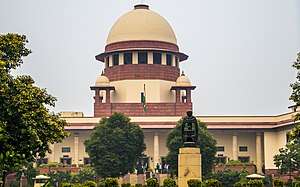The Supreme Court possesses original jurisdiction in cases involving disputes between states or cases affecting foreign ambassadors and consuls. Appellate Jurisdiction: The majority of cases reach the Supreme Court on appeal from lower federal or state courts. The Court has discretion over which cases it hears.
- Supreme Court Jurisdiction
- Landmark Supreme Court Cases
- Supreme Court Appointments
- Supreme Court and Civil Rights
- Supreme Court Justices
- Supreme Court and Constitutional Interpretation
- Supreme Court and Social Issues
- Supreme Court and the Separation of Powers
- Supreme Court and Technology
- Supreme Court Around the World
- Frequently Asked Questions (FAQs)
Supreme Court Jurisdiction
- Original Jurisdiction: The Supreme Court possesses original jurisdiction in cases involving disputes between states or cases affecting foreign ambassadors and consuls.
- Appellate Jurisdiction: The majority of cases reach the Supreme Court on appeal from lower federal or state courts. The Court has discretion over which cases it hears.
- Constitutional Interpretation: The Court has the authority to interpret the U.S. Constitution, settling disputes on its interpretation and application.
- Federal Law and Statutes: It reviews cases involving federal laws and statutes, ensuring uniformity in their application across the nation.
- Constitutional Challenges: The Court addresses constitutional challenges to state and federal laws, determining their constitutionality.
- Landmark Decisions: Many historic decisions, such as Brown v. Board of Education and Roe v. Wade, have shaped American society through the Court’s jurisdiction.
- Legal Precedent: Its rulings set legal precedent, influencing subsequent cases and establishing principles of law.
- Checks and Balances: The Court’s jurisdiction is a vital component of the U.S. system of checks and balances, ensuring the law’s consistent interpretation and application throughout the nation.



Landmark Supreme Court Cases
| Case | Description | Impact |
|---|---|---|
| Brown v. Board of Education (1954) | Ended racial segregation in public schools. | Catalyst for the civil rights movement; overturned Plessy v. Ferguson. |
| Roe v. Wade (1973) | Legalized abortion in the United States. | Sparked ongoing debate on reproductive rights and privacy. |
| Marbury v. Madison (1803) | Established judicial review; the Court’s power to invalidate laws. | Strengthened the judiciary’s role in checking legislative actions. |
| Miranda v. Arizona (1966) | Established Miranda warnings for suspects in custody. | Safeguarded Fifth Amendment rights during police interrogations. |
| Gideon v. Wainwright (1963) | Right to legal counsel for indigent defendants. | Ensured fair trials for all, regardless of financial status. |
| Dred Scott v. Sandford (1857) | Denied citizenship to African Americans. | Deepened sectional tensions; later overturned by the 14th Amendment. |
| Obergefell v. Hodges (2015) | Legalized same-sex marriage nationwide. | Expanded LGBTQ+ rights and recognition of marriage equality. |
| Citizens United v. FEC (2010) | Allowed unlimited corporate campaign spending. | Influenced campaign finance laws and sparked debates on influence. |
Supreme Court Appointments
Nomination Process: The President nominates candidates, typically based on their legal qualifications, ideology, and party affiliation.
Senate Confirmation: The Senate Judiciary Committee holds hearings to assess the nominee’s qualifications and ideology. A majority Senate vote confirms or rejects the nominee.
Lifetime Tenure: Justices serve for life, providing long-term stability in the Court’s composition.
Ideological Balance: Presidents often seek to influence the Court’s ideological balance by nominating justices who align with their political beliefs.
Controversial Nominations: Some nominations have faced significant opposition, such as the failed nomination of Robert Bork in 1987.
Changing Ideological Trends: Justices’ views may evolve over time, impacting the Court’s decisions and ideological direction.
Historic Appointments: Notable appointments, like Thurgood Marshall as the first African American justice and Sandra Day O’Connor as the first female justice, have broken barriers.
Legacy and Impact: Appointments shape the Court’s decisions for decades, influencing American law and society on issues ranging from civil rights to healthcare and more.



Supreme Court and Civil Rights
| Civil Rights Issue | Supreme Court Role | Impact |
|---|---|---|
| Segregation (Brown v. Board of Education, 1954) | Declared state laws enforcing school segregation unconstitutional. | Paved the way for desegregation in public education and civil rights movement. |
| Voting Rights (Shelby County v. Holder, 2013) | Struck down key provisions of the Voting Rights Act. | Weakened federal oversight over voting practices, leading to concerns of voter discrimination. |
| Affirmative Action (Grutter v. Bollinger, 2003) | Upheld the use of race as a factor in university admissions. | Preserved affirmative action policies in higher education. |
| LGBTQ+ Rights (Obergefell v. Hodges, 2015) | Legalized same-sex marriage nationwide. | Extended marriage equality to LGBTQ+ couples across the U.S. |
| Equal Protection (Loving v. Virginia, 1967) | Struck down laws prohibiting interracial marriage. | Invalidated anti-miscegenation laws, promoting marriage equality. |
| Gender Equality (Ginsburg v. Virginia, 1971) | Ruled that gender-based discrimination violates the Constitution. | Laid groundwork for women’s rights and gender equality cases. |
| Disability Rights (Olmstead v. L.C., 1999) | Supported community-based care for individuals with disabilities. | Promoted integration and equal treatment for disabled individuals. |
Supreme Court Justices
- Appointment: Justices are nominated by the President and confirmed by the Senate, serving life terms, ensuring judicial independence.
- Current Composition: As of my last knowledge update in September 2021, the Supreme Court consisted of nine justices, with varying ideological leanings.
- Chief Justice: The Chief Justice presides over Court proceedings and administers the oath of office to the President.
- Influence on Law: Justices interpret the Constitution and make decisions that impact American law on issues like civil rights, abortion, and healthcare.
- Divisions and Alignments: Justices often form liberal, conservative, or swing-vote blocs, affecting the outcome of cases.
- Notable Justices: Historical figures include John Marshall, Thurgood Marshall, Ruth Bader Ginsburg, and Clarence Thomas, each leaving a distinct mark on the Court’s jurisprudence.
- Legacy: Justices’ decisions and legal philosophies can have lasting effects on American society, shaping policies and legal precedents for generations.
Supreme Court and Constitutional Interpretation
| Role in Constitutional Interpretation | Description | Impact |
|---|---|---|
| Guardian of the Constitution | The Court interprets the Constitution’s text, intent, and principles to ensure adherence to its framework. | Safeguards the fundamental principles of the U.S. system of government. |
| Judicial Review | Marbury v. Madison (1803) established the Court’s authority to review and invalidate laws that conflict with the Constitution. | Shapes the balance of power among the three branches of government. |
| Defining Constitutional Rights | The Court identifies and defines constitutional rights, such as freedom of speech, religion, and the right to bear arms. | Shapes individual liberties and legal protections for citizens. |
| Adapting to Changing Society | Interpretations evolve to address societal changes, as seen in cases related to technology, civil rights, and privacy. | Ensures the Constitution remains relevant in contemporary contexts. |
| Landmark Decisions | Key rulings like Brown v. Board of Education and Roe v. Wade have reshaped societal norms and legal standards. | Influences public policy, politics, and the nation’s moral compass. |
| Balancing Federalism | The Court navigates federalism by defining the limits of state and federal government authority. | Maintains a balance between state sovereignty and federal power. |
Supreme Court and Social Issues
- Abortion (Roe v. Wade, 1973): The Court’s decision legalized abortion, but ongoing cases and challenges impact access and restrictions.
- LGBTQ+ Rights (Obergefell v. Hodges, 2015): Legalized same-sex marriage, extending marriage equality nationwide.
- Civil Rights (Brown v. Board of Education, 1954): Ended racial segregation in public schools, catalyzing the civil rights movement.
- Freedom of Speech (Various Cases): The Court has ruled on cases involving hate speech, campaign financing, and online expression.
- Religion (Employment Division v. Smith, 1990): Established limits on religious exemptions from laws, impacting religious freedom cases.
- Privacy (Roe v. Wade, Griswold v. Connecticut): Recognized a right to privacy, affecting issues like reproductive rights and surveillance.
- Immigration (Various Cases): The Court has addressed immigration policies, including detention and deportation.
- Affirmative Action (Grutter v. Bollinger, 2003): Upheld the use of affirmative action in university admissions.
Supreme Court and the Separation of Powers
| Role in Separation of Powers | Description | Impact |
|---|---|---|
| Checks and Balances | The Court serves as a check on the executive and legislative branches, ensuring they act within constitutional bounds. | Maintains the equilibrium of power among the three branches. |
| Judicial Review | The Court’s authority to review and invalidate laws and actions of the other branches enforces constitutional limits. | Prevents overreach by the executive and legislative branches. |
| Interpreting Executive Actions | The Court interprets the legality of presidential actions, affecting executive orders, foreign policy, and national security. | Defines the boundaries of executive authority and accountability. |
| Resolving Disputes | Resolves conflicts between the executive and legislative branches, such as cases involving executive privilege or congressional subpoenas. | Ensures a fair and constitutional resolution of interbranch conflicts. |
| Preserving Democracy | By upholding democratic principles, the Court safeguards the separation of powers, ensuring government accountability and citizens’ rights. | Fosters a stable and functioning democratic system. |
Supreme Court and Technology
- Digital Privacy (Riley v. California, 2014): Ruled that law enforcement generally needs a warrant to search the contents of a smartphone, addressing modern privacy concerns.
- Net Neutrality (Various Cases): The Court’s decisions or non-decisions have influenced the regulation of internet service providers and the concept of net neutrality.
- Intellectual Property (Various Cases): The Court has tackled issues related to copyright, patents, and intellectual property in the digital age.
- Surveillance (Carpenter v. United States, 2018): Limited warrantless cell phone location tracking, recognizing the implications of constant digital surveillance.
- Free Speech Online (Various Cases): Rulings have addressed the boundaries of free speech on social media and online platforms.
- E-Commerce (South Dakota v. Wayfair, 2018): Altered the taxation landscape for online sales, affecting businesses and state revenues.
- Fourth Amendment Challenges: The Court grapples with applying the Fourth Amendment to emerging technologies like drones and facial recognition.
Supreme Court Around the World
| Country | Highest Court | Role and Characteristics |
|---|---|---|
| United States | Supreme Court of the United States | Interprets federal law, resolves constitutional disputes, and ensures adherence to the U.S. Constitution. |
| United Kingdom | Supreme Court of the United Kingdom | Hears appeals on significant legal issues, including constitutional matters, replacing the House of Lords as the highest court. |
| Canada | Supreme Court of Canada | Decides constitutional questions, provides final rulings on federal and provincial legal matters, ensuring legal consistency. |
| India | Supreme Court of India | Guarantees the supremacy of the Indian Constitution, protecting fundamental rights and settling disputes between states. |
| Australia | High Court of Australia | Ensures uniform interpretation of the Australian Constitution, resolves disputes, and interprets federal laws. |
| South Africa | Constitutional Court of South Africa | Safeguards the post-apartheid constitution, protecting human rights, and ensuring adherence to constitutional principles. |
| Germany | Federal Constitutional Court (Bundesverfassungsgericht) | Upholds the Basic Law (Grundgesetz), ensuring constitutional adherence and protecting individual rights. |
| France | Constitutional Council (Conseil constitutionnel) | Reviews the constitutionality of laws, ensuring compliance with the French Constitution, and protecting civil liberties. |
Frequently Asked Questions (FAQs)
There are nine justices on the Supreme Court, including the Chief Justice.
Supreme Court justices are nominated by the President and must be confirmed by the Senate.
Justices serve lifetime appointments, which means they remain on the Court until they retire, resign, or pass away.
The Chief Justice presides over Court sessions, assigns opinions, and administers the oath of office to the President during inauguration.
The Court has both original and appellate jurisdiction, with original jurisdiction in cases involving disputes between states and appellate jurisdiction over various federal and state cases.






